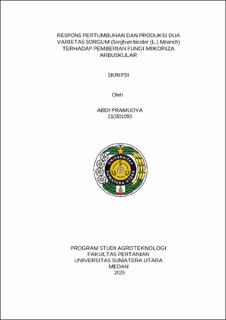Respons Pertumbuhan dan Produksi Dua Varietas Sorgum (Sorghum bicolor (L.) Moench) terhadap Pemberian Fungi Mikoriza Arbuskular
Growth and Production Responses of Two Sorghum Varieties (Sorghum bicolor (L.) Moench) to the Application of Arbuscular Mycorrhizal Fungi
Abstract
Sorghum is a crop with potential for development as a food diversification
commodity. Sorghum production remains low compared to its potential yield, with
one of the main causes being limited availability of nutrients, particularly
phosphorus. Efforts to increase yields can be made through the use of high-yielding
varieties and the utilization of arbuscular mycorrhizal fungi, which can enhance
nutrient and water absorption efficiency. This study aims to determine the growth
and production responses of two sorghum varieties to the application of arbuscular
mycorrhizal fungi. The research was conducted in Binjai Timur Subdistrict, Binjai
City, at an elevation of approximately 25 meters above sea level, and at the Soil
Biology Laboratory of the Faculty of Agriculture, Universitas Sumatera Utara,
from January to May 2025. This study used a two-factor split-plot design with three
replications. The main plots were the sorghum varieties: Numbu and Bioguma, and
the subplots were the doses of arbuscular mycorrhizal fungi: 0, 5, 10, and 15 g. The
results showed that the Bioguma variety differed significantly from the Numbu
variety in terms of plant height at 3-4 MST, panicle weight, fresh weight of the cob,
fresh weight of the roots, seed weight per sample, and seed weight per plot.
Arbuscular mycorrhizal fungi inoculation had a significant effect on plant height at
8-9 MST, root colonization percentage, wet weight of the cob, wet weight of the
roots, seed weight per sample, seed weight per plot, and 1000-seed weight.
Treatment interactions significantly affected plant height at 5-7 MST, panicle
weight, and dry panicle weight.
Collections
- Undergraduate Theses [3569]

